Hellenic Karst Aquifers Vulnerability Approach Using Factor Analysis: The Example of the Louros Karst Aquifers
Abstract
:1. Introduction
2. Methodology
3. The Hellenic Karst
- The “paleokarst” that was developed during the upper Cretaceous and upper–lower Miocene under warm–wet climates (Savanna type), which is not currently evolving and is considered as inactive, fossilized.
- The “younger karst” that was developed during Pleistocene–Holocene between the interglacial periods, under climatic conditions that are usually warmer and wetter than today. The main karstification process of the Greek territory took place during the same period, and was also accompanied by the creation of new karst forms, and sometimes the reactivation of older ones that often continue to evolve, even to this day.
- The “recent karst”, which is created under the current climatic conditions, and is characterized by surface karst features, e.g., karrens.
3.1. The Role and Presence of the Epikarstic Zone in General, and in the Hellenic Karst
- (a)
- The coastal karst aquifers of Trifylia consist of Eocene carbonate formations, while the corresponding areas of Almyros spring in Heraklion area consist of the Triassic carbonate rocks of the Ionian zone and Cretaceous limestones of the Gavrovo–Tripolis zone.
- (b)
- The karst system of the Louros Basin consists of carbonate formations of the Ionian zone. From the springs’ discharge data for the Eocene limestones of the area, a long memory emerged just as in the previous case (lag time between 70–100 days) corresponding to increased porosity, which is explained by the presence of the epikarst zone [2,37]. It was also found that the very good drainage of the aquifers corresponds to a developed karst system.
- (c)
- The karst system hosted in the marbles of Aggitis presented similar results regarding the autocorrelation and cross-correlation functions, and thus similar characteristics with the above-mentioned systems [13]. The lag time of 50 days for the autocorrelation function was attributed to the system’s long memory, corresponding to an increased storage, which could explain the huge water reserves that were calculated by the recharge area of the springs. Given the very low porosity that was measured in the area, the increased memory was attributed to the presence of snow that accumulates on mountain tops and can play a regulatory role in the discharge of the springs’ groundwater. According to [14], the increased memory could also be attributed to the presence of the epikarst zone.
3.2. The Louros Basin: Area of Application
3.2.1. Geological and Hydrogeological Setting of Louros Basin
3.2.2. The Pollution Sources and Origin of Groundwater in Louros Basin
3.2.3. The Application of R-Mode Factor Analysis in Louros Basin
4. Discussion and Conclusions
Funding
Acknowledgments
Conflicts of Interest
References
- USEPA Publications. US EPA Quality Criteria for Water; USEPA Publications: Washington, DC, USA, 1976.
- Katsanou, K. Environmental Hydrogeological Study of Louros watershed, Epirus, Greece. Ph.D. Thesis, Department of Geology, University of Patras, Rio, Greece, 2012. [Google Scholar]
- D’Alessandro, W.; Katsanou, K.; Lambrakis, N.; Bellomo, S.; Brusca, L.; Liotta, M. Chemical and isotopic characterisation of bulk deposition in the Louros Basin (Epirus, Greece). Atmos. Res. 2013, 132–133, 399–410. [Google Scholar] [CrossRef]
- Parkhurst, D.L.; Appelo, C.A.J. Description of Input and Examples for PHREEQC Version 3-A Computer Program for Speciation, Batch-Reaction, One-Dimensional Transport and Inverse Geochemical Calculations: U.S. Geological Survey Techniques and Methods. 2013. Available online: http://pubs.usgs.gov/tm/06/a43/ (accessed on 5 November 2018).
- Kallergis, G. Applied—Environmental Hydrogeology, 2nd ed.; TEE: Athens, Greece, 2001; ISBN 978-960-7018-73-1. [Google Scholar]
- Papadopoulou-Vrinioti, K. Hellenic karst and Environment. In Proceedings of the 3rd Pan-Hellenic Geographical Conference, Athens, Greece, 1–3 April 1993; pp. 290–299. [Google Scholar]
- Riedl, H.; Papadopoulou-Vrinioti, K. Comparative Investigations on Karst Generations Mainly in the Aegean Archipelago. Mitt. Natutwiss Ver. Steiermark 2001, 131, 23–39. Available online: https://www.zobodat.at/pdf/MittNatVerSt_131_0023-0039.pdf (accessed on 1 June 2018).
- Koumantakis, I.E. Research of Kefalonia Aquifers, Geographical and Morphological Data, Geological Conditions and Hydrogeology. Unpublished Technical Report. 1990. [Google Scholar]
- Mastoris, K. Hydrogeological Investigation in the Karstic Limestone Area of South Ghiona. Ph.D. Thesis, NTUA, Athens, Greece, 1968. [Google Scholar]
- Monopolis, D. Hydrogeological Study of the Karst Area of the Mountainous Complex of Parnassos. Ph.D. Thesis, Athens, Greece, 1971. [Google Scholar]
- Morphis, A. Hydrogeological Research of the Karst Aquifer System of Parnitha and the Wider Area of Northern Attica. Ph.D. Thesis, University of Patras, Rio, Greece, 2005. [Google Scholar]
- Papadopoulos, K. Hydrogeological Research of the Wider Area of Koziakas Mountain Range (Western Thessaly). Ph.D. Thesis, University of Patras, Rio, Greece, 2004. [Google Scholar]
- Novel, J.-P.; Dimadi, A.; Zervopoulou, A.; Bakalowicz, M. The Aggitis karst system, Eastern Macedonia, Greece: Hydrologic functioning and development of the karst structure. J. Hydrol. 2006, 334, 477–492. [Google Scholar] [CrossRef]
- Lambrakis, N. The Hellenic karst. Propositions for research methodologies and application examples. In Proceedings of the 11th International Hydrogeological Congress of Greece, Athens, Greece, 4–6 October 2017. [Google Scholar]
- Cvijic, J. Državna štamparija Kraljevine Srba; Hrvata i Slovenaca: Zagreb, Beograd, 1926. [Google Scholar]
- Mandilaras, D.; Voudouris, K.; Soulios, G. Hydraulic parameters in the karstic aquifer system of Greece. In Proceedings of the International Conference “All about karst & water”, Vienna, Austria, 10–11 October 2006; pp. 118–129. [Google Scholar]
- Smyrniotis, C. Preliminary Report of Louros Karst System Hydrogeological Study; Technical Report; Institute of Geological and Mineral Research: Thessaloniki, Greece, 1991; ISBN 960-602-058-4. [Google Scholar]
- Gospodaric, R.; Habic, P. Poljes of hotoussa, levidi and northern tripolis. In Karst Hydrogeology of the Central and Eastern Peloponnesus (Greece); Morfis, A., Zojer, H., Eds.; Steirische Beiträge zur Hydrogeologie: Graz, Austria, 1986; pp. 169–185. [Google Scholar]
- Lambrakis, N.; Katsanou, K.; Siavalas, G. Geothermal fields and thermal waters of Greece: An overview. In Geothermal Systems and Energy Resources: Turkey and Greece, 1st ed.; Baba, A., Bundschuh, J., Chandrasekharam, D., Eds.; CRC Press, Taylor and Francis Group: London, UK, 2014; pp. 25–46. ISBN 9781138001091. [Google Scholar]
- Mangin, A. Sur la dynamique des transferts en aquifére karstique. In Proceedings of the 6th International Congress of Speleology, Olomouc, Czech Republic, 22–28 July 2017. [Google Scholar]
- Mangin, A. Contribution A L’etude Hydrodynamique Des Aquiferes Karstiques. Ph.D. Thèse, Université de Dijon, Dijon, France, 1975. [Google Scholar]
- Kiraly, L.; Morel, C. Remarques sur l’hydrogramme des sources karstiques simule par modeles mathematiques. Bull. Cent. Hydrogeol. 1992, 1, 37–60. [Google Scholar]
- Bakalowicz, M.; Blavoux, B.; Mangin, A. Apports du ravage isotopique naturel a la connaissance du fonctionnement d’un systeme karstique-leneurs en oxygene 18 de trois systemes des Pyrenees, France. J. Hydrol. 1974, 23, 141–158. [Google Scholar] [CrossRef]
- Klimchouk, A.B.; Stotland, V.J.; Lomaev, A.A. Karstological and speleological investigations of the Kyrktau massif (Zeravshansky Ridge, Tjan-Shan). Izvestija VGO 1979, 11, 117–123. Available online: https://www.researchgate.net/publication/273276723 (accessed on 1 June 2018).
- Klimchouk, A.B.; Rogozhnikov, V.; Ja Lomaev, A.A. Karst of the Kyrklau Massif, Zeravshansky Ridge; Institute of Geological science: Kiev, Ukraine, 1981.
- White, W.B.; White, E.L. Karst landforms and drainage basin evolution in the Obey River Basin, north-central Tennessee. J. Hydrol. 1983, 61, 69–82. [Google Scholar] [CrossRef]
- Aquilina, L.; Ladouche, B.; Dorfliger, N. Water storage and transfer in the epikarst of karstic systems during high flow periods. J. Hydrol. 2016, 327, 472–485. [Google Scholar] [CrossRef]
- Bakalowicz, M. La zone d’infiltration des aquifères karstiques. Méthodes d’étude/Structure et fonctionnement. Hydrogéologie 1995, 4, 3–21. [Google Scholar]
- Einsield, F. Flow system dynamics and water storage of a fissured porous karst aquifer characterized by artificial and environmental tracers. J. Hydrol. 2005, 279, 312–321. [Google Scholar] [CrossRef]
- Perrin, J.; Jeannin, P.Y.; Zwahlen, F. Epikarst storage in a karst aquifer, a conceptual model based on isotopic data, Milandre test site, Switzerland. J. Hydrol. 2003, 279, 106–124. [Google Scholar] [CrossRef]
- Fidelibus, M.D.; Balacco, G.; Gioia, A.; Iacobellis, L.; Spilotro, G. Mass transport triggered by heavy rainfall: The role of endorheic basins and epikarst in a regional karst aquifer. Hydrol. Process. 2017, 31, 394–408. [Google Scholar] [CrossRef]
- Mangin, A. Pour une meilleure connaissance des systemes hydrologiques a partir des analyses correlatoires et spectrales. J. Hydrol. 1984, 67, 25–43. [Google Scholar] [CrossRef]
- Padilla, A.; Pulido-Bosch, A. Study of hydrographs of karstic aquifers by means of correlation and cross-spectral analysis. J. Hydrol. 1995, 168, 73–89. [Google Scholar] [CrossRef]
- Bouchaou, L.; Mangin, A.; Chauve, P. Turbidity mechanism of water from a karstic spring: Example of the Ain Asserdoune spring (Beni Mellal Atlas, Marocco). J. Hydrol. 2002, 265, 34–42. [Google Scholar] [CrossRef]
- Panagopoulos, G.; Lambrakis, N. The contribution of time series analysis to the study of the hydrodynamic characteristics of the karst systems: Application on two typical karst aquifers of Greece (Trifilia, Almyros Crete). J. Hydrol. 2006, 329, 368–376. [Google Scholar] [CrossRef]
- Bonacci, O.; Fistanic, I. Contribution to hydrological analysis of the coastal karst spring Almyros (Crete, Greece). In Proceedings of the Conference on Water Observation and Information System for Decision Support, Balwois, Ohrid, Macedonia, 25–29 May 2004. [Google Scholar]
- Katsanou, K.; Lambrakis, N.; Tayfur, G.; Baba, A. Describing the Karst Evolution by the Exploitation of Hydrologic Time-Series Data. Water Resour. Manag. 2015, 29, 3131–3147. [Google Scholar] [CrossRef] [Green Version]
- Soulios, G. General Hydrogeology; Kyriakidis Bros Publishing House: Thessaloniki, Greece, 2004; Volume III. [Google Scholar]
- Katsikatsos, G. Geology of Greece; Patras University Publications: Pátra, Greece, 1992. [Google Scholar]
- Karakitsios, V.; Pomoni-Papaioannou, F. Sedimentological Study of the Triassic Solution-collapse Breccias of the Ionian zone (NW Greece). Carbonate Evaporites 1998, 13, 207–218. [Google Scholar] [CrossRef]
- Skourtsis-Coroneou, V.; Solakius, N. Calpionellid zonation at the Jurassic/Cretaceous boundary within the Vigla Limestone Formation (Ionian Zone, western Greece) and carbon isotope analysis. Cretac. Res. 1999, 20, 583–595. [Google Scholar] [CrossRef]
- Nikolaou, E.; Lagaris, V. Technical Report on the Results of the Drilling Research (May 1987–November 1988) Epirus, Greece; Institute of Geological and Mineral Research: Preveza, Greece, 1990. [Google Scholar]
- Nikolaou, E.; Pavlidou, S.; Katsanou, K. Aquifer systems of Epirus, Greece: An overview. In Advances in the Research of Aquatic Environment, Environmental Earth Sciences; Lambrakis, N., Stournaras, G., Katsanou, K., Eds.; Springer: Berlin/Heidelberg, Germany, 2011; Volume 1, pp. 425–434. ISBN 978-3-642-19901-1. [Google Scholar]
- IGRS-IFP (Institut de Géologie et Recherches du Sous-sol–Institut Français du Pétrole). Etude Géologique de l’Epire (Grèce Nord-Occidentale); Editions Technip: Paris, France, 1966. [Google Scholar]
- Katsanou, K.; Lambrakis, N. Modeling the Hellenic karst catchments with the Sacramento Soil Moisture Accounting model. Hydrogeol. J. 2017, 25, 757–769. [Google Scholar] [CrossRef]
- Katsanou, K.; Lambrakis, N.; D’Alessandro, W.; Siavalas, G. Chemical parameters as natural tracers in hydrogeology: A case study of Louros karst system, Greece. Hydrogeol. J. 2017, 25, 487–499. [Google Scholar] [CrossRef]
- Vareli, K.; Briasoulis, E.; Pilidis, G.; Sainis, I. Molecular confirmation of Planktothrix rubescens as the cause of intense, microcystin-Synthesizing cyanobacterial bloom in Lake Ziros, Greece. Harmful Algae 2009, 8, 447–453. [Google Scholar] [CrossRef]
- Dawson, R.M. The toxicology of microcystins. Toxicon 1998, 36, 953–962. [Google Scholar] [CrossRef]
- Otten, T. Toxic Algal Blooms Behind Klamath River Dams Create Health Risks Far Downstream. Oregon State University. 2016. Available online: http://today.oregonstate.edu/archives/2015/jun/toxic-algal-blooms-behind-klamath-river-dams-create-health-risks-far-downstream (accessed on 5 November 2018).
- Lambrakis, N.; Antonakos, A.; Panagopoulos, G. The use of multicomponent statistical analysis in hydrogeological environmental research. Water Res. 2004, 38, 1862–1872. [Google Scholar] [CrossRef] [PubMed]
- Davis, J.C. Statistics and Data Analysis in Geology; Wiley: New York, NY, USA, 1986; ISBN 0471837431. [Google Scholar]
- IBM Corp. In IBM SPSS Statistics for Windows; Version 24.0; IBM Corp: Armonk, NY, USA, 2016.
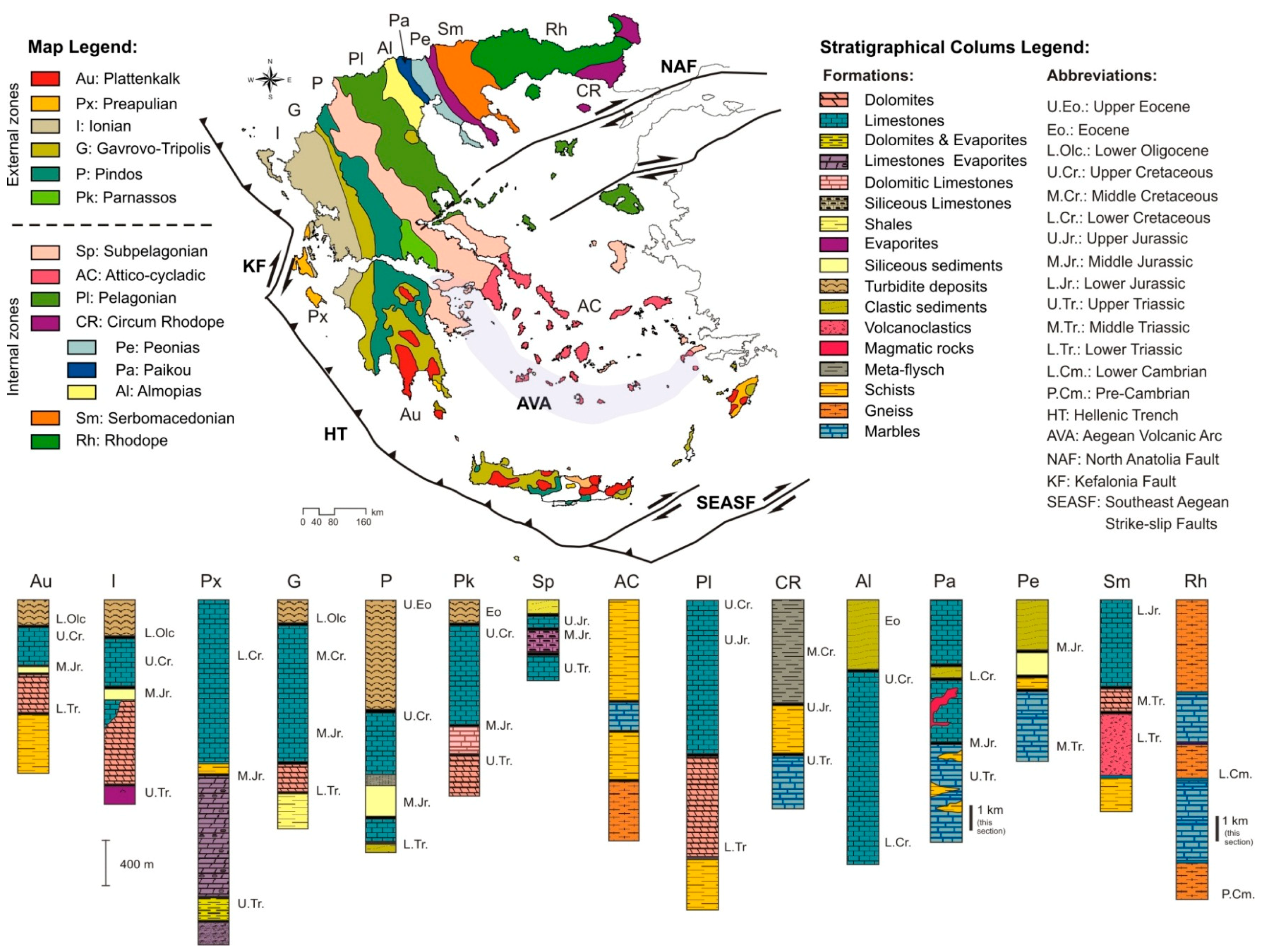
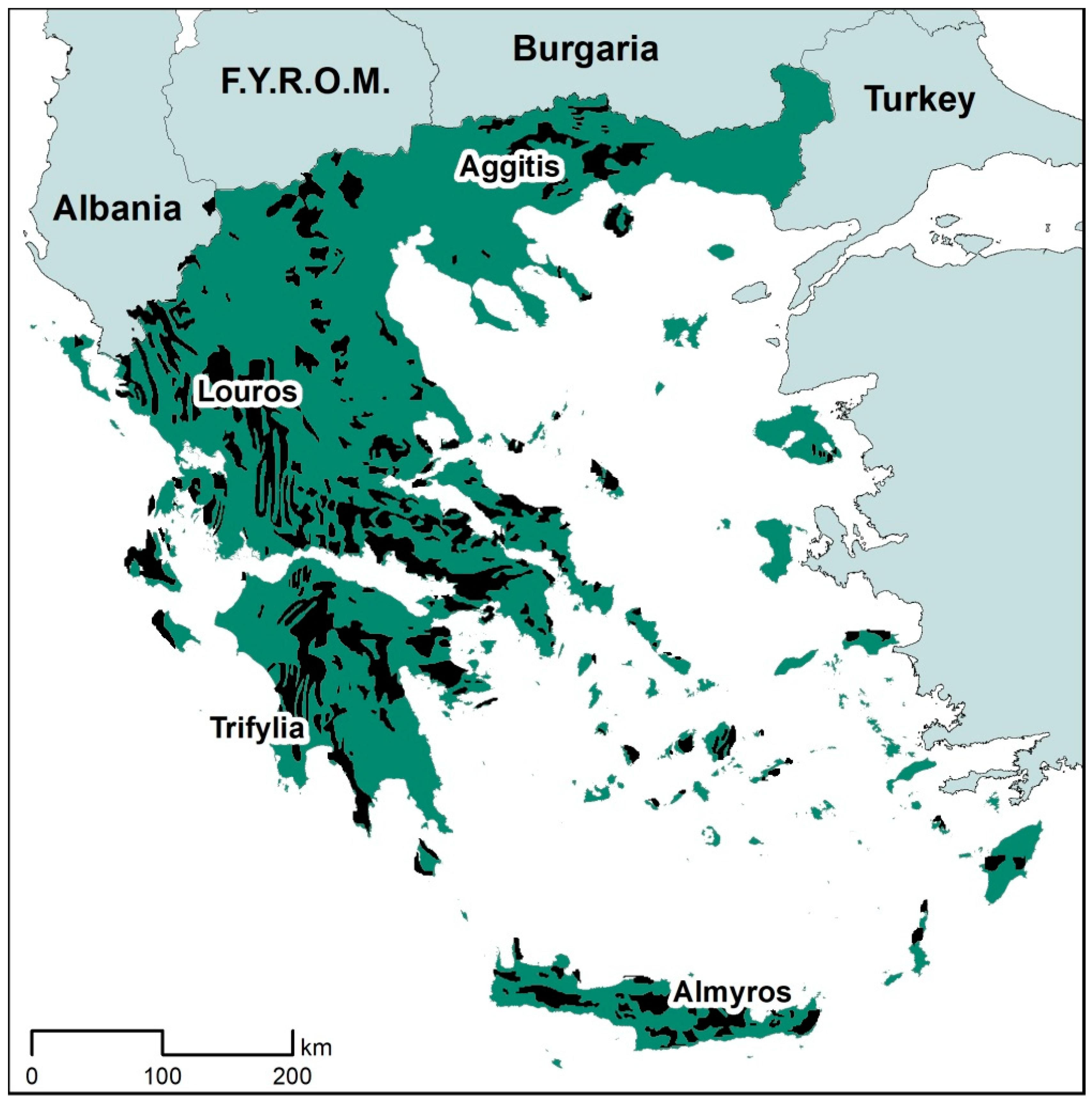
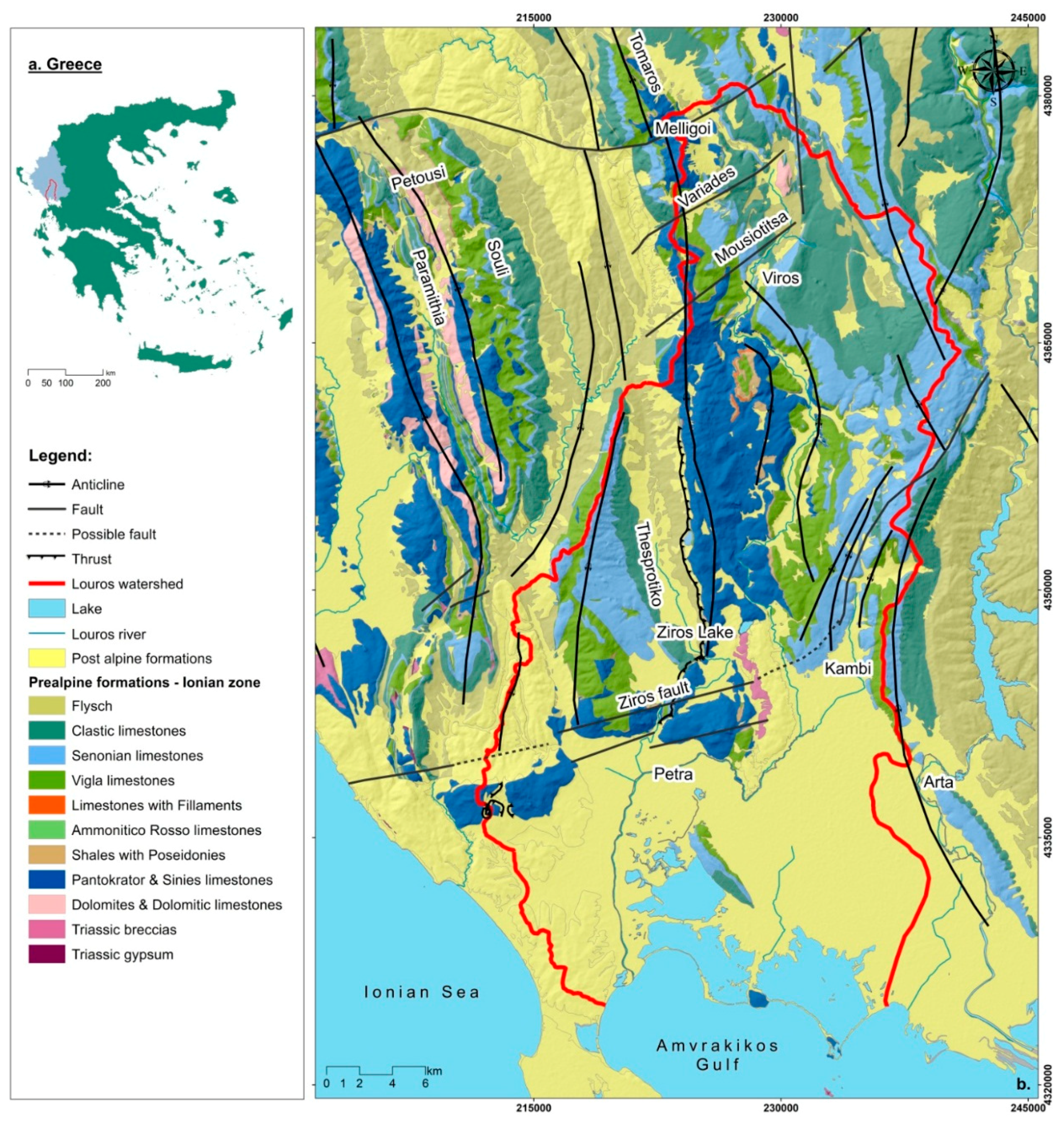
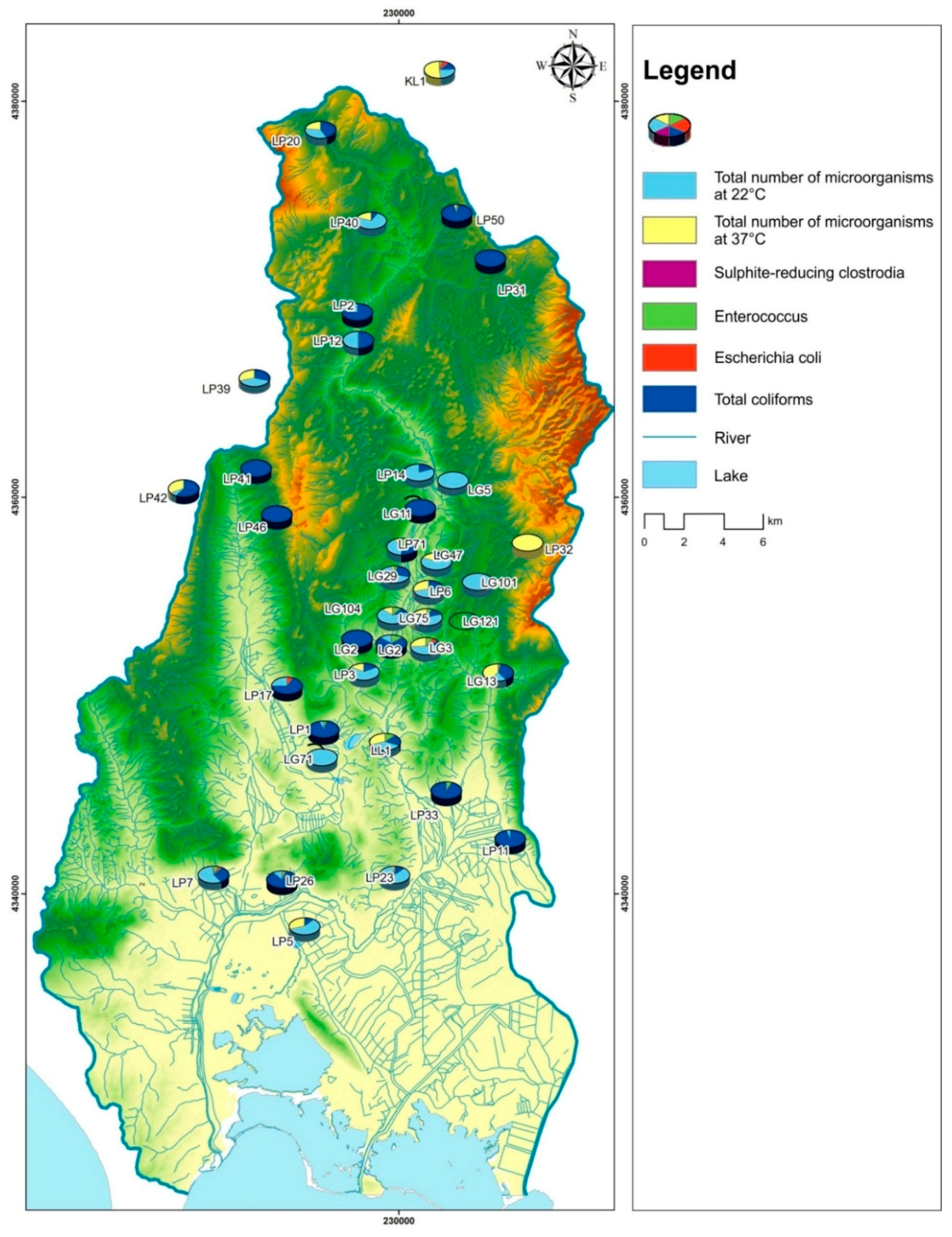
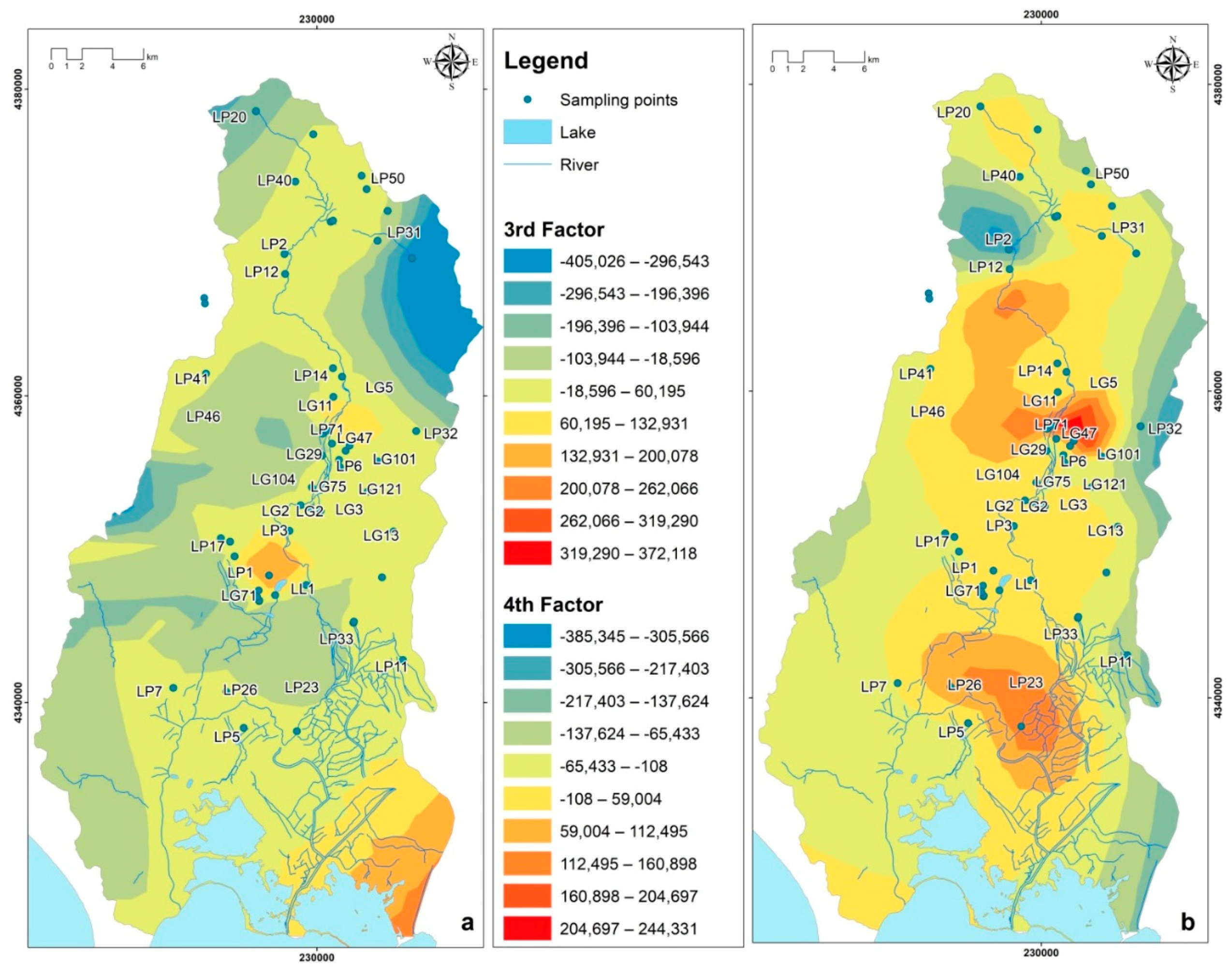
| Total | % of Variance | Cumulative % |
|---|---|---|
| 1 | 2 | 3 |
| 6.412 | 42.745 | 42.745 |
| 2.299 | 15.328 | 58.073 |
| 1.530 | 10.202 | 68.275 |
| 1.274 | 8.496 | 76.770 |
| First Factor | Second Factor | Third Factor | Fouth Factor | |
|---|---|---|---|---|
| Twa | 0.802 | |||
| Eh | −0.527 | |||
| pH | −0.609 | |||
| HCO3 | 0.927 | |||
| K | 0.884 | |||
| Na | 0.946 | |||
| Mg | 0.952 | |||
| Ca | 0.847 | |||
| NH3 | 0.637 | |||
| NO3 | 0.686 | |||
| NO2 | 0.556 | |||
| SO4 | 0.893 | |||
| P | 0.935 | |||
| SiO2 | 0.559 | |||
| Cl | 0.958 |
© 2018 by the author. Licensee MDPI, Basel, Switzerland. This article is an open access article distributed under the terms and conditions of the Creative Commons Attribution (CC BY) license (http://creativecommons.org/licenses/by/4.0/).
Share and Cite
Katsanou, K. Hellenic Karst Aquifers Vulnerability Approach Using Factor Analysis: The Example of the Louros Karst Aquifers. Geosciences 2018, 8, 417. https://doi.org/10.3390/geosciences8110417
Katsanou K. Hellenic Karst Aquifers Vulnerability Approach Using Factor Analysis: The Example of the Louros Karst Aquifers. Geosciences. 2018; 8(11):417. https://doi.org/10.3390/geosciences8110417
Chicago/Turabian StyleKatsanou, Konstantina. 2018. "Hellenic Karst Aquifers Vulnerability Approach Using Factor Analysis: The Example of the Louros Karst Aquifers" Geosciences 8, no. 11: 417. https://doi.org/10.3390/geosciences8110417





